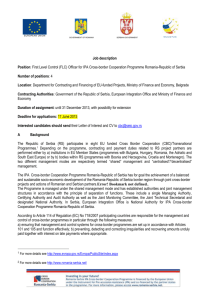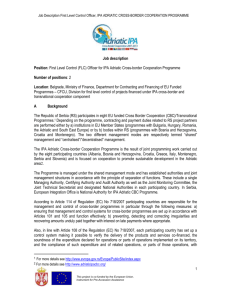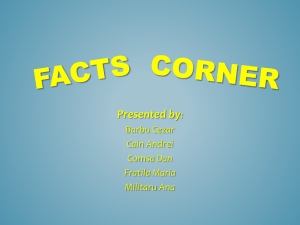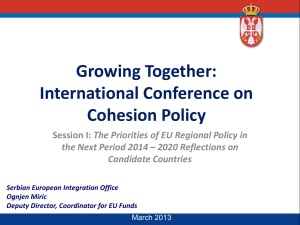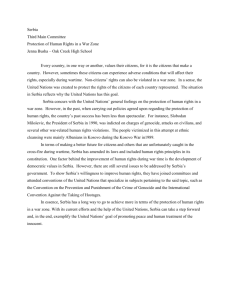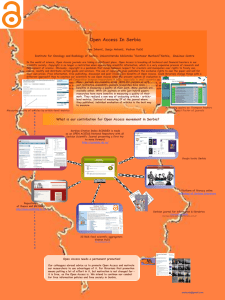Scoping report - Interreg-IPA Cross
advertisement
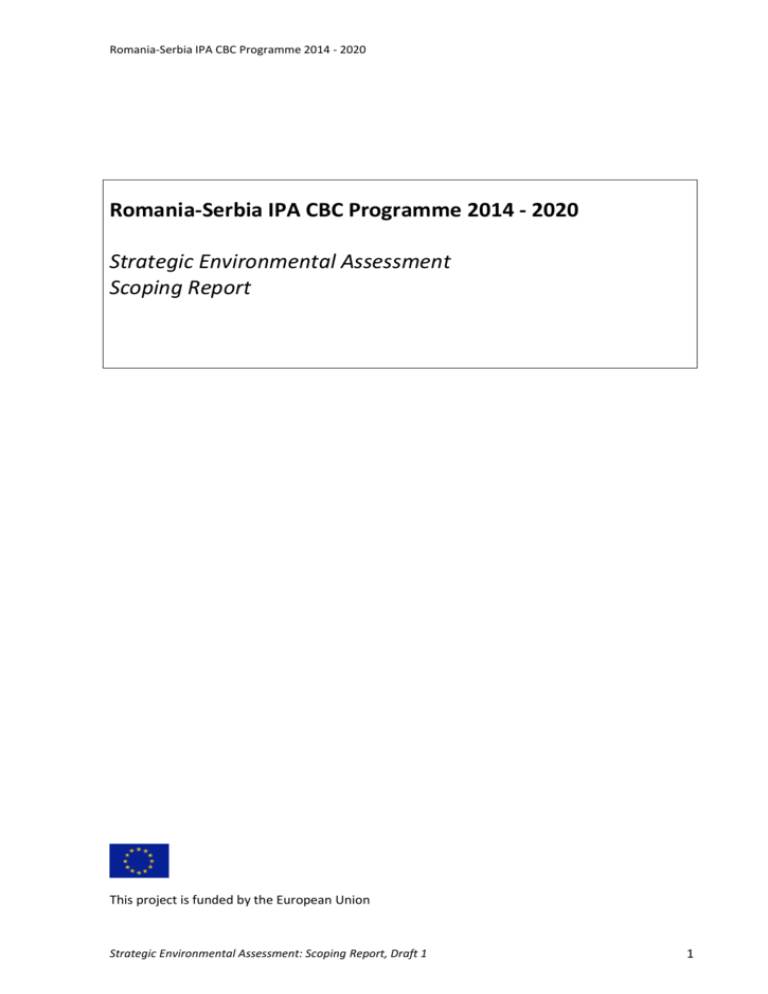
Romania-Serbia IPA CBC Programme 2014 - 2020 Romania-Serbia IPA CBC Programme 2014 - 2020 Strategic Environmental Assessment Scoping Report This project is funded by the European Union Strategic Environmental Assessment: Scoping Report, Draft 1 1 Romania-Serbia IPA CBC Programme 2014 - 2020 Disclaimer: The contents of this publication are the sole responsibility of the authors. Authors: This document has been prepared within Ex-ante assessment and SEA for Romania-Serbia IPA CBC Programme 2014 - 2020´ implemented by Ernst & Young SRL with technical inputs on SEA matters by Integra Consulting Ltd. Contact to the consulting service provider: Ernst & Young SRL Bucharest Tower Center, 22nd Floor, 15-17 Ion Mihalache Blvd., Bucharest 011171, Romania Contact to the lead author: Ing. Jiří Dusík, Partner Integra Consulting Ltd., jiri.dusik@integracons.com +420-603214487 Strategic Environmental Assessment: Scoping Report, Draft 1 2 Romania-Serbia IPA CBC Programme 2014 - 2020 TABLE OF CONTENTS GLOSARY ______________________________________________________________ 4 1 INTRODUCTION ______________________________________________________ 5 1.1 2 3 4 Purpose of the Scoping Report _______________________________________________ 5 DETERMINING THE SUBJECT OF THE PROGRAMME TO THE SEA ___________________ 6 2.1 The outline of the programme _______________________________________________ 6 2.2 Objectives and areas of intervention __________________________________________ 6 2.3 Sectors that the programme covers ___________________________________________ 6 DETERMINING THE LIKELY SIGNIFICANCE OF EFFECTS ___________________________ 9 3.1 Environmental effects at regional and transboundary level ________________________ 9 3.2 Characteristics of the affected territory ________________________________________ 9 3.3 Characteristics of the environmental effects of the programme ____________________ 11 DEFINING THE SCOPE OF THE ASSESSMENT _________________________________ 11 4.1 Relevant plans, programmes and environmental protection objectives ______________ 11 4.2 Identified environmental problems __________________________________________ 12 4.3 SEA Objectives __________________________________________________________ 13 4.4 Baseline information______________________________________________________ 14 4.5 Methods of the assessment ________________________________________________ 20 5 STRUCTURE OF THE SEA REPORT ________________________________________ 21 6 SEA PROCEDURE ____________________________________________________ 22 6.1 7 Consultations ___________________________________________________________ 22 EXPECTED ENVIRONMENTAL EFFECTS ON THIRD COUNTRIES ____________________ 22 Strategic Environmental Assessment: Scoping Report, Draft 1 3 Romania-Serbia IPA CBC Programme 2014 - 2020 GLOSARY Term or acronym Definition CBC Cross-Border Cooperation IPA The EU Instrument for Pre-Accession Assistance SEA Strategic Environmental Assessment SEA Directive Directive 2001/42/EC of the European Parliament and of the Council of 27 June 2001 on the assessment of the effects of certain plans and programmes on the environment. Scoping Determination of scope of the Strategic Environmental Assessment Strategic Environmental Assessment: Scoping Report, Draft 1 4 Romania-Serbia IPA CBC Programme 2014 - 2020 1 INTRODUCTION 1.1 Purpose of the Scoping Report This document outlines key characteristics of the proposed IPA CBC Programme for Romania-Serbia for the programming period 2014 - 2020 (hereafter Romania-Serbia IPA CBC Programme 2014 - 2020) which is available at the state of initiation of the strategic environmental assessment (SEA) for this programming document. The document provides information for relevant environmental authorities in Serbia and Romania in order to obtain their advice on the scope of the SEA study that should be elaborated - based on the decision of the managing Authority for Romania-Serbia IPA CBC Programme 2014 - 2020 - during July and August 2014. Strategic Environmental Assessment: Scoping Report, Draft 1 5 Romania-Serbia IPA CBC Programme 2014 - 2020 2 DETERMINING THE SUBJECT OF THE PROGRAMME TO THE SEA 2.1 The outline of the programme The scoping document is prepared for 2nd draft (July 2014) of the Romania-Serbia IPA CBC Programme 2014 - 2020 which has been elaborated within “Technical assistance for multi-annual programming of future cross border cooperation programme in the Romania-Serbia cooperation area” 2.2 Objectives and areas of intervention According to the results of the analysis and the identified needs and challenges, and based on the lesson learned from the current programme, four priorities have been established, each of one connected to one thematic objective: 1. 2. 3. 4. Employment promotion and basic services strengthening for an inclusive growth (thematic objective a) Environmental protection and risk management (thematic objective b) Sustainable mobility and accessibility (thematic objective c) Attractiveness for sustainable tourism (thematic objective d) 2.3 Sectors that the programme covers As stated above, the programme covers four thematic objectives with logically corresponding sectoral interventions that are outlined below. For each of use, we have highlighted in those interventions that may possibly have adverse environmental impacts in red colour (those that warrant increased attention are marked in bold) and those interventions with the likely positive impacts in green colour (those that warrant increased attention are marked in bold). Other interventions - all the rest of text not highlighted in red or green - are not likely to have significant environmental impacts. Thematic objective A ´Employment promotion and basic services strengthening for an inclusive growth´ suggests to promote the following types of interventions : Employment and labor mobility: Set up of joint initiatives and cross border networks for the identification of potentials of employment and the removal of obstacles to the access to the labor market by disadvantaged groups. Set up of joint initiatives targeting young active people, to promote their access to the labor market Set up of cross border initiatives for the capitalization of potentials and facilitation of cross border mobility in the local labor markets. Joint initiatives, cooperation, exchange of information, coordination of activities and services among professional associations for the promotion of employment and entrepreneurial initiatives, especially among young unemployed, women, disadvantaged groups. Development of cross-border services for adult trainings, assistance to job seekers, assistance to returning emigrants for the re-integration in the local labor market. Health and social infrastructures: Strategic Environmental Assessment: Scoping Report, Draft 1 6 Romania-Serbia IPA CBC Programme 2014 - 2020 Set up of cross-border platforms and networks for planning and provision of health and social services, including remote communities and disadvantaged groups. Joint studies and researches for the identification of innovative technological solutions for the organization of effective networks for basic services provision Set up of monitoring services for the identification of needs and the quantification of demands for new social and health services generated by demographic and social dynamics, like aging, and migration Joint planning of investments for equipment and small infrastructures for the provision of health and social services, targeting communities across the borders. Social and cultural inclusion: Set up of cross-border frameworks, and networks for the strengthening of the cross-border cultural exchange; Design cross-border actions for social and cultural inclusion through innovative solutions such as social enterprises, voluntary organisations, special interest groups etc. Set up models and test pilot actions for a better participation of all social groups, actors and users in the design and delivery of cultural services and services of general interest. Thematic objective B ´Environmental protection and risk management´ suggests to promote the following types of interventions: Environmental protection and sustainable use of natural resources. Establishment and enhancement of cross border partnerships and networks of research institutions in the field of energy efficiency, usage of geothermal hot springs, water, sun and wind power for producing electric energy, including investments in infrastructure based on common and tailored technical solutions Set up of cross-border frameworks, platforms and networks for the exchange of experience and the identification of needs for state authorities, volunteers organizations and individuals involved or interested in environmental protection; Development of joint training and awareness programmes for relevant organisations and the general public including educational institutions; Establishment and enhancement of cross border partnerships and networks of research institutions in the field of natural resources, biodiversity, technologies for environmental protection, for the identification and transfer of innovations tailored to the local needs. Establishment of networks and partnerships for joint training actions for public entities and local communities in the field of environmental protection, enhancement of pollution control strategies and systems; conduction of joint trainings and maintenance of interoperability including the purchase of compatible equipment. Joint initiatives and investments in small infrastructures and equipment for the implementation of technologies for the control of pollution and rehabilitation of rivers (e.g. Tisa river) and brown fields and industrial areas with common problems on the two sides of the border (e.g. Moldova Nouă Mines, Resița Industrial areas) ; Restoration of natural areas (e.g. woods and river banks) to prevent floods and land slides. Environmental risks management and emergency preparedness Development of joint structures and partnerships for the integration of the involved state authorities and volunteers organizations on initiatives in relation to the Danube Strategy (Danube River Basin Management, ICPDR initiatives, European Floods Alert System etc.), including the investments in small infrastructures and equipment; Establishment and enhancement of cross border liaison in the environmental planning of the involved state authorities and volunteers organizations including joint risk mapping of accident risk spots, risk assessment and evaluation exercises; Strategic Environmental Assessment: Scoping Report, Draft 1 7 Romania-Serbia IPA CBC Programme 2014 - 2020 Development of joint procedures for the establishment and maintenance, and integration in international networks, in particular Danube Region, of databases on environmental resources and environmental risks; Promotion of data availability and the integration of management approaches (hazard and risk assessment, planning methodologies, management plans, sustainability and adaptation assessments, monitoring and evaluation etc.); Establishment of networks and partnerships for joint training actions for public entities and local communities in the field of environmental protection, management of environmental emergencies; joint trainings and maintenance of interoperability including the purchase of compatible equipment; Establishment of joint services for the management and control of risks generated by hot spots of industrial pollution (e.g. ICP Prahovo; industrial poles in Mehedinți County) Thematic objective C ´ Sustainable mobility and accessibility´ suggests to promote the following types of interventions: Mobility and transport infrastructures and services Establishment and enhancement of cross border partnerships of the involved state authorities for the planning of physical infrastructures; Joint studies for the preparation of cross-border infrastructure investments with emphasis on multimodal solutions; Set up of cross-border frameworks, platforms and networks for the identification of innovative solutions in the field of cross border mobility, including ICT interventions, alternatives modal and public/private transport networks; Development and upgrading of the road infrastructure and cross-border crossing points, and improvement/acceleration of procedures linked to mobility of persons and goods; Support of upgrades of the infrastructures at the border stations, and improvement/acceleration of procedures linked to mobility of persons and goods. Public utilities infrastructure, Set up of cross-border frameworks, platforms and networks for the exchange of experience and the identification of needs for service providers involved; Development of joint information and awareness rising programmes for relevant organisations, local administrations, and the general public for the provision of basic utilities to the local communities, specially in remote areas. Joint feasibility studies and models design for planning of infrastructure investments with emphasis on locally-adapted solutions (e.g. small-scale water treatment, access to ICT, renewable energy ) for areas facing similar challenges on both side of the border; (e.g. JKP Badnjevo, Ada, water treatment) Thematic objective D ´Attractiveness for sustainable tourism´ suggests to promote the following types of interventions: Promotion of innovative tourism activities and networks based on the common natural and cultural resources The growth of cross border networks of tourism clusters, attracting visitors from the national and international markets; Integration of local tourism attractions in the international networks of the Danube Basin. The growth of visitors and tourism services, based on the establishment of a common brand and image for the local touristic offer attracting additional demand; The increase in the occupancy rate of tourist infrastructures, in all areas and for the diversified typologies of tourism; Strategic Environmental Assessment: Scoping Report, Draft 1 8 Romania-Serbia IPA CBC Programme 2014 - 2020 The establishment of touristic networks across the border, exploiting synergies and sharing innovative management and technological solutions; The investment for the creation of small infrastructures for the provision of innovative services in the touristic sector, for specific forms of tourism, like cultural tourism, naturalistic tourism, thematic tourism., Enhancement of capacities and skills for the improvement quality and quantity of tourism services and products in common networks and partnerships Enhancement of capacities among entrepreneurs and workers of the tourist sector, for the improvement of the quality of tourists services, and the diversification of tourist products; Improvement of the information and knowledge on natural and cultural resources, for the implementation of conservation strategies and the promotion of sustainable tourism networks; 3 DETERMINING THE LIKELY SIGNIFICANCE OF EFFECTS 3.1 Environmental effects at regional and transboundary level As evident from the proposed sector interventions outlined in chapter 2.3., will likely to achieve overall positive environmental impacts. The following interventions may have adverse impacts that warrant increased attention: Joint studies for the preparation of cross-border infrastructure investments with emphasis on multimodal solutions; Set up of cross-border frameworks, platforms and networks for the identification of innovative solutions in the field of cross border mobility, including ICT interventions, alternatives modal and public/private transport networks; Development and upgrading of the road infrastructure and cross-border crossing points, and improvement/acceleration of procedures linked to mobility of persons and goods; Support of upgrades of the infrastructures at the border stations, and improvement/acceleration of procedures linked to mobility of persons and goods. With regard to the above list, a question arises as to whether these interventions may lead to significant impacts that could not managed through more detailed studies on project-level )such as EIA, or standard types of permits related to environmental matters that are already in place in Romania and Serbia) and whether SEA is actually needed. In the view of the author of this report, the none of impacts is likely to be significant effects based on the criteria for determining the likely significance of effects stipulated in the Annex II of the SEA Directive. In this regard, it is proposed to undertake a simplified form of SEA and focus it on providing suggestions for detailed planning of each of the intervention in order to reduce possible risks and maximize their environmental benefits. 3.2 Characteristics of the affected territory The eligible area for the programming period 2014-2020 under the IPA CBC programme Serbia Romania will include three counties of Romania, and the six districts of the Republic of Serbia . The programme area is at the centre of the European Danube Macro Region. The two partner countries include a large share of the river basin, their total surface representing 10% of the basin in Serbia and 29% in Romania. Strategic Environmental Assessment: Scoping Report, Draft 1 9 Romania-Serbia IPA CBC Programme 2014 - 2020 The total area is 40.596 sqkm (53,1 % in Romania/ 46,9% in Serbia), including the Romanian counties Timiş, Caraş-Severin and Mehedinţi, and the Serbian districts (Severno Banatski, Srednje Banatski, Južno Banatski, Braničevski, Borski, Podunavska). Map 1 The eligible area of the Romania Serbia IPA CBC Programme The eligible area is split in two NUTS2 regions in Romania, and two NUTS2 regions in Serbia. In Serbia, the three Banat districts belong to the Autonomous Province of Vojvodina, an administrative entity classified as NUTS2 statistical region according to the law 46/2010, which has revised the territorial statistical units in Serbia according to the EU criteria. The Braničevski, Borski and Podunavska districts belong to the NUTS2 statistical region of Southern and Eastern Serbia. In Romania, Mehedinti County belongs to the Development Region South West. The two counties of Caraș-Severin and Timiș belong to the development Region West. The geography of the region is complex and heterogeneous. The Banat Plains extend in the North in the Serbian Districts and Timiș County. Moving to South East, transition hills between the plans and Mountains lead to the centre occupied by the Southern Carpathians range, with Banat Mountains, Țarcu-Godeanu Mountains and Cernei Mountains and elevations between 600 and 2100 meters in Caraș Severin district. The Danube flows in the South Banat plains, at the border with the Braničevski district, and it reaches the border between Romania and Serbia in the vicinity of Baziaș in Romania. In Romania, Timiș, Cerna, Caraș and Nera rivers cross the counties, some of them through spectacular valleys and gorges. Also worth to mention the Bega channel, connected to the Rhine – Danube network. Between the southern Carpathian Mountains and the north-western foothills of the Balkan Mountains, the Danube flows through the Iron Gates gorges (Iron Gates is another name of Đerdapska klisura and it is from Golubac to Simska klusura, 98 km. The Đerdap water gate is half on Romanian and half on Serbian side.). The Romanian side of the gorge constitutes the Iron Gates natural park, whereas the Serbian part constitutes the Đerdap national park. In the South East is the Western end of the Southern Carpathians. In the Borski district are Veliki Krš, Mali Krš and Stol mountains, dominated by karst formations, and are collectively known as "Gornjanski kras”. In Strategic Environmental Assessment: Scoping Report, Draft 1 10 Romania-Serbia IPA CBC Programme 2014 - 2020 Romania are the Mehedinţi Mountains with heights of up to 1500 m. The heights decrease towards the South East, passing through the hills to a high plain to the Western end of the Romanian Plain. 3.3 Characteristics of the environmental effects of the programme The SEA will consider the following key issues of concern Biodiversity Landscape Flooding and droughts, Water quality Soil erosion and contamination industrial pollution events and contamination 4 DEFINING THE SCOPE OF THE ASSESSMENT 4.1 Relevant plans, programmes and environmental protection objectives Romania-Serbia IPA CBC Programme 2014 - 2020 has important relationship to two strategic documents that address environmental protection matters related to the study area. These are: EU Strategy for Danube Region Romania EU Partnership Agreement National Plan for the Adoption of the acquis communitaire (2103-2016) of the Republic of Serbia. The EU Strategy for Danube Region (EUSDR) The Romania Serbia CBC Programme contributes to and interacts with, the Macro Regional strategy that the EU has devised for the countries and regions that share common needs and objectives in the Danube Region. The newly elaborated EU Strategy for the Danube Region (DRS) provides an overall framework for parts of Central and South East Europe area aiming at fostering integration and integrative development. The Danube Region covers 12 countries (Austria, the Slovak Republic, the Czech Republic, Hungary, Slovenia, Romania and Bulgaria as Member States of the EU as well as Croatia, Serbia, Bosnia and Herzegovina, Montenegro and the Republic of Moldova) plus the ‘Danubian’ regions of Germany and the Ukraine. Thus, the Danube Region encompasses the entire RO-SR CBC programme area. The open-ended EU Strategy for the Danube Region was adopted in December 2010. The strategy includes four pillars (1) Connecting the Danube Region, (2) Protecting the environment in the Danube Region, (3) Building prosperity in the Danube Region and (4) Strengthening the Danube Region. The Romania EU Partnership Agreement EU strategic Frameworks: Romania Partnership Agreement The last draft of the Romanian Partnership Agreement submitted to the EC in April 2014, highlights the central role of the CBC programmes participated by Romania, for the contribution to the EU development strategy. Strategic Environmental Assessment: Scoping Report, Draft 1 11 Romania-Serbia IPA CBC Programme 2014 - 2020 The Partnership Agreement emphasizes the importance of promoting the EUSDR, as macroeconomic strategies offer a new, more substantial and consistent cooperation platform that can be financed not only from dedicated funds. The planned EUSDR Romania interventions include five different areas, namely transport (e.g.: development of bridges and port infrastructure), settlements network (e.g.: connecting Bucharest and the Danube river), environment (e.g.: protection of the Danube Delta), society (e.g.: improvement of social infrastructure) and economy (e.g.: exploiting the agricultural, energy and tourism potential of the Danube area). According to the RO Partnership Agreement, CBC programs should also emphasize the importance of promoting employment, improving tourism and promoting cultural heritage while enhancing the connection between the communities of the border areas. Improvement of the transport and environmental system is also promoted. Romania is committed to remove the existing bottlenecks concerning the cross-border transport flows and to strengthen cooperation especially in the energy sector –in order to raise energy efficiency, decrease pollution and to widen the production, distribution and consumption of renewable energy sources. The National Plan for the Adoption of the acquis communitaire (2103-2016) of the Republic of Serbia. According to the National plan, the Republic of Serbia is highly motivated to develop relations with immediate neighbours and countries in the region of South-East Europe, thus affirming one of the priorities of its foreign policy – improvement of regional cooperation. In the strategy of Serbia, regional cooperation, especially through regional fora and initiatives, although not replacing the process of integration to the EU, represents a central contribution to strengthening of bilateral relations with the neighbours and the states from the South - East Europe region. Republic of Serbia is actively contributing specially to the Danube Macro Region Strategy, thus assigning a special role to the CBC Programme RO–SR, for the contribution to the wider strategy, and the creation of an integrated framework for the achievement of the EUSDR objectives. 4.2 Identified environmental problems The 1st draft of the proposed OP (page 20) outlines the following key environmental strengths and weaknesses of the study area as follows: Divide of land use and land cover with agriculture dominating in the Northwest and mountain and forested areas dominating in the southeast, with punctual foci of human activity (e.g. mines); Rich natural environment and cultural heritage with many small and dispersed attractions which is at pressure either by abandonment in peripheral areas or by overexploitation in the plains; Large number of NATURA 2000 and Natural Protected Areas covering a large part of the programme area; Rivers and water bodies mostly heavily modified and with weak ecological potential burdened by agricultural, industrial and municipal discharges; Relative low level of service of water supply and sewage treatment especially in the rural areas and difficulties to overcome this by conventional approaches; Environmental Infrastructure, is often obsolete, underperforming and with limited perspective for financing beyond rudimentary operation and maintenance; Municipal waste treatment is nascent and is relying in simple landfills or uncontrolled dumps; Strategic Environmental Assessment: Scoping Report, Draft 1 12 Romania-Serbia IPA CBC Programme 2014 - 2020 Air pollution in the urban centres as a consequence of traffic and poor industrial emissions standards; Environmental hotspots and risks, especially due to past and present mining and industrial activity, in many cases in remote areas with poor civil protection mechanisms; Flood risks (fluvial and flash floods) in different parts of the Programme area; Flood Awareness Systems and disaster protection improving and connecting to European networks but still poor at the local level 4.3 SEA Objectives The most important environmental reference framework for the proposed Romania-Serbia IPA CBC Programme 2014 - 2020 are the priorities defined in the environmental pillar of the EU Strategy for the Danube Region. EUSDR environmental pillar focuses on three Priority Areas which have to be integrated with other policies: Restore and maintain the quality of waters; Manage environmental risks; Preserve biodiversity, landscapes and the quality of air and soil. The objectives for the Priority Area ‘To restore and maintain the quality of waters’ are: 1. Achieve the management objectives set out in the Danube River Basin Management Plan”. - i.e. achieve: a. good ecological/chemical status of surface water bodies; b. good ecological potential and chemical status of Heavily Modified Water Bodies and Artificial Water Bodies; c. good chemical/quantitative status of groundwater bodies. 2. Reduce the nutrient levels in the Danube River to allow the recovery of the Black Sea ecosystems to conditions similar to 1960s. 3. Secure viable populations of Danube sturgeon species 4. Elaborate, adopt and implement the sub-basin management plans, such as Sava, Tisza and Prut sub-basins. The objectives for the Priority Area ‘To manage environmental risks’ (floods, past environmental liabilities and industrial accidents) are: 5. Implement Danube wide flood risk management plans - due in 2015 under the Floods Directive – to include significant reduction of flood risk by 2021, also taking into account potential impacts of climate change”. 6. Update of the accidental risk spots inventory at the Danube River Basin level by 2013”. The objectives for the Priority Area ‘To preserve biodiversity, landscapes and the quality of air and soils’ are: 7. To halt the deterioration in the status of all species and habitats covered by EU nature legislation and achieve a significant and measurable improvement, adapted to the special needs of the Danube Region by 2020”. 8. Secure viable populations of Danube sturgeon species and other indigenous fish species by 2020”. 9. Reduce by 25% the area affected by soil erosion exceeding 10 tonnes per hectare by 2020”. 10. By 2020, ecosystems and their services are maintained and enhanced by establishing green infrastructure and restoring at least 15% of degraded ecosystems”. 11. By 2020, Invasive Alien Species and their pathways are identified and prioritised, priority species are controlled or eradicated, and pathways are managed to prevent the introduction and establishment of new Invasive Alien Species”. Strategic Environmental Assessment: Scoping Report, Draft 1 13 Romania-Serbia IPA CBC Programme 2014 - 2020 The SEA will appraise the proposed Romania-Serbia IPA CBC Programme 2014 - 2020 against the above specified 11 targets defined in the environmental pillar of the EU Strategy for the Danube Region. 4.4 Baseline information Environmental baseline information from the Republic of Serbia Biodiversity, flora, fauna General information It is estimated that in Serbian territory over 1000 species of flora is endangered, according to the Red list of Serbian flora (2002). Most of the endangered plants in Serbia is in the IUCN category of “rare plants”. The most endangered part in Serbia’s biodiversity considers the forest ecosystems and especially sensitive ecosystems (e.g. wetland habitats, prairie habitats, continental salt marshes, sandy terrains, mountain habitats) some of which are refugial habitats for relict and endemic species. NATURA 2000 represents the political basis of protection for EU nature and biological diversity. NATURA 2000 is not a strict system of reserves where human activity is prohibited. It includes areas with strict regime of protection, but better part of this network remains in private property where it is extremely important to ensure sustainable management for these areas both in ecologic and economic aspects. Establishment of network for protected areas represents fulfillment of requirements toward UN Convention for biological diversity. EMERALD network is European ecological network of spatial units and habitats which are of special national and international significance in the aspect of preserving biodiversity and comprised of Areas of Special Conservation Interest (ASCI) in territory of all Convention signatory countries. By the Convention criteria for preservation of wild flora and fauna and natural habitats a list of potential EMERALD areas is made and it includes 61 areas. Overall area is 1.019.269 ha which is 11.54% of Serbian territory. Some of these areas are in districts which are being studied in this programme. Likely future trends The systems of natural and semi-natural areas, the ecological corridors and surrounding areas form a coherent ecological network system. The EU 2020 Biodiversity Strategy sets out specific targets for ecosystem services, maintenance and re- establishment of spatial planning and the integration of green infrastructure. The main risk factor is human intervention, but it is also important to prepare against certain natural influences. The natural and cultural values are mainly endangered by intensive agriculture, illegal material gain, and infestation by invasive species. Constructive co-operation between different authorities and more effective involving of different stakeholders (farmers, authorities, municipalities, NGOs, and academic institutions) is necessary. It is essential to rehabilitate the degraded habitats, growing areas with the involvement of farmers as much as possible. In the future, special attention should be paid to climate change on habitats and living communities, and the rehabilitation and reconstruction tasks as well. Strategic Environmental Assessment: Scoping Report, Draft 1 14 Romania-Serbia IPA CBC Programme 2014 - 2020 Landscape There are several objects with important landscape values in the designated districts, and should be therefore taken into consideration. National Park Đerdap A blend of time and nature on land and water, the largest national park in Serbia, Djerdap National Park, is located in north-eastern Serbia, on the border with Romania. Spanning 637.99 square kilometers along 100 km of the Danube’s right bank, from Golubac to Karataš near Kladovo, the National Park comprises zones with various protection regimes for natural objects, cultural monuments, fauna and relict plant species, which illustrate the development of vegetation series from times immemorial until the present day. The first level of protection comprises 8.83% ie. 56.33 km2 territory of the Park, the second degree comprises 21.03% ie. 134.15 km2, and finally, the third level comprises 70.14% ie. 447.51 km2. Djerdap National Park is often called ‘river national park’ because the Danube makes up a significant portion of the Park. The miraculous Iron Gate, the largest and longest water breakthrough in Europe, is also a natural botanical garden and the biggest European archeological open-air museum. Deliblato Sands Special Nature Reserve Deliblato sands Area /Deliblatska Pescara/ is the Special Nature Reserve located in southern part of Banat, 50 km from Belgrade, 40 km from Romania border between the Danube river and the western Carphatian slopes. The Deliblato Sands is a geo-morphological formation of eolian origin of exceptional specific beauty and multiple scientific importance, created during the Ice age by wast quantities of eolian silicate and carbonate sands. Deliblato Sands is of diluvial origin and makes the largest European continental sands area. Deliblato Sands Nature Reserve is the largest oasis of sand, steppe, forest and wetland vegetation on the Pannonian Plain. Sand that spread all over the vast Pannonian Plain caused great problems in the past. Deliberate planting of numerous trees began during the reign of Queen Maria Theresa that contributed to rich vegetation in present time. Deliblato Sands covers the total size of 33.610 hectars. This wide and unique European natural phenomenon is characterized mostly by ellipsoid-shaped sand masses up to 15 km in lenght. There individual sand dunes reach lenght of 750 meters and heights near 60 meters. Deliblato sands area is the only sandy terrain in Europe originated from the Pannonian Sea withdrawals 35 km long and wide 9-12 kilometers. Due to its marvelous forest and unspoiled surroundings, it was proclaimed to be the Special Nature Reserve. Deliblato Sands Area attract nature-lovers, eco-researches, fishermen and hunters. Within the borders of The Special Nature Reservation of Deliblato Sands there are 2 strict and 16 geneticall reserves and 6 natural monuments. Due to specific natural and climatic conditions, although it is at the altitude of only 200 m, Deliblato sands has a climate similar to the mountain. Deliblatska peščara is poorly populated, with few villages, mostly on the outskirts of the reserve. Deliblato Sands Area is known as "The European Sahara". It is natural habitat of numerous herbs and animal species, specially rare birds and game. Deliblato Sands Area is on UNESCO tentative list of Protected Natural Heritage. Special Nature Reserve Meadows of Great Bustard – Mokrin Category IV in IUCN classification, Habitat and Species Management Area. Located in Northern Banat in the area of Kikinda and Čoka Municipalities covering the space of 979 ha. Habitat for natural rarity Great Bustard (Otis Tarda), one of the most endangered bird species in Europe and world. This is the Strategic Environmental Assessment: Scoping Report, Draft 1 15 Romania-Serbia IPA CBC Programme 2014 - 2020 only remaining habitat for this species in Serbia and former Yugoslavia. It also has a mosaic complex of plant communities, both specific for some localities and typical Pannonian phytocoenosis or for the region of Northern Banat as a whole. Most diverse type of vegetation is salt marsh vegetation. Also specific and rare flora (Pannonian endemic and subendemic species and other rare species). Specific insect, amphibian, reptilian, bird and mammal fauna with a high degree of diversity and also other nature rarities (2/3 of birds have natural rarity status). The current state indicates an increase in population of Great Bustard. Level II protection, and has two separate zones, A and B. Special Nature Reserve Slano Kopovo – Novi Bečej In the year 2001, 976 hectares of “Slano Kopovo”, a special nature reserve, was declared by the Serbian Government as a natural value of the utmost significance, rated first category. The Association of Huntsmen from Novi Becej has been nominated as its official trustee. Slano Kopovo represents one of the last preserved salt land marshes in Vojvodina. In the past, the river Tisa used to change its course frequently, flooding the nearby plains, so “Slano Kopovo” is one of the ancient meanders of the river Tisa. Slano Kopovo is an immeasurable center of the biological diversity of the flora and fauna on the territory of Vojvodina as well as an example of salty habitats at the verge of complete disappearance. It is one of the most important and most particular bird habitats in Serbia, as well as in the middle Europe. Slano Kopovo is the nesting place for a number of rare and endangered species of birds, but even more important is its significance as an en route station for birds in migration from many parts of Europe and from west Siberia. Slano Kopovo is a very special place for birds such as cranes, snipes, herons, ducks and geese. During the migration period in the spring and in the autumn, here in Slano Kopovo over 15000 grey cranes (Grus grus), over 20 000 different species of ducks, and over 5000 geese can gather in just one moment. Special Nature reserve “Stari Begej –Carska bara“ Special Nature reserve “Stari Begej –Carska bara“ is located on the alluvial plain of the Rivers Begej and Tisa close to the road directions connected with Zrenjanin, Belgrade, Novi Sad etc. This is the complex of 1,676 ha consisting of the river bed of the River Begej, Carska bara (Imperial Marsh), Tiganjica, Zegmenjica, Mala bara (Small Marsh), Perleska bara and neighboring bogland. Being the nature reserve Carska Bara is the habitat for 240 rare species of birds,out of which 130 are non-migratory and 110 migratory. Therefore this nature reserve is one of the most important stations in Europe. Due to its natural resources it is included in the list of the Ramsar, IBA and IPA region. As it is one of the most important resting places on the migration route of migratory birds, some species stay only ten days, and some like the Siberian wild geese, abide there during winters (hibernate). All of eight species of herons built their nests in Carska bara, so the heron has become a trademark of the reserve. Within the rich and varied bird colony, there are other types, such as the pelican, coot, white-tailed eagle, hen harries and western marsh harriers, cormorant, Eurasian Sparrow hawk and others. In the mosaic disposition of forest, meadow, prairie and wetland vegetation some rare and protected plant species such as white and yellow water lilies, plum thistles, wild flowers, water chestnut LooseFlowered Orchid etc, have found their habitat. Natural monument Lazarev kanjon Lazarev Kanjon (‘Lazar’s Canyon’) is in eastern Serbia and is part of eastern Kučaj. Lazarev Kanjon is important for its relief, its water-formed features and its natural life. It was formed by the erosive action of the Lazareva Reka river, a right tributary of the Zlotska Reka river. This magnificent canyon Strategic Environmental Assessment: Scoping Report, Draft 1 16 Romania-Serbia IPA CBC Programme 2014 - 2020 is carved into the limestone of the Dubašnička Ravan, and is joined by the more shallow, smaller canyons of the Milujska Reka and Pojenska Reka rivers, as well as by the Demizloka canyon. Lazarev Kanjon is one of the least negotiable canyons in Serbia. It is 4.5 km long, 350 to 500 m deep, and at its narrowest is 4 m wide. It is notable for its vertical limestone cliffs with a flattened limestone plateau from which the carving of the valley began. It is also unique for its variety of surface and underground karst relief forms such as karst valleys, sinkholes, karren, kamenica, caves and caverns. More than 70 caves and potholes have been discovered in the area of Lazarev Kanjon, the most significant being Lazareva Pećina and Vernjikica. The area is also of interest for its variety of forms of surface and subterranean waters. The flora of this region is some 50% more diverse than the flora of the national parks of Kopaonik, Šara and Djerdap, and as much as 5 times more diverse than the flora of Serbia as a whole, which is an indication of its significance as a centre of floral diversity in the Balkans. The plant life is characterised by numerous and varied endemic and subendemic plants, as well as by the presence of 52 relict plant species dating back to various geological eras. Lazarev Kanjon is a region populated by Italian and Turkish oak, together with oriental hornbeam, though a total of 16 tree and 10 plant communities have been recorded. The territory of the Lazareva Pećina cave is home to 57 tall and short tree species and 27 shrub species. This is a major centre of European deciduous tree species and a rare refuge of the Stankewicz pine. Also very important are the Austrian black pine woods on the canyon cliff-edges and the beech and pine woodlands. The canyon is home to 35 species of mammal (bats, chamois and others), 96 bird species (Golden Eagle, Peregrine Falcon, Eagle Owl, Tawny Owl, Wallcreeper, Yellow-billed Chough, Common Kingfisher, Syrian Woodpecker, Red-rumped Swallow and others), 9 reptile species, 8 amphibian species and numerous, as yet insufficiently studied species of insect and cave fauna. Nature Park Vršačke planine Vršačke planine (rum. Munţii Vârşeţ, also known as Vršački Breg, rum. Dealurile Vârşeţului) are located in the middle of Pannonian Plane in southwestern part of Banat. They cover a space of 170 square kilometers, of which 122 are in Serbia and 48 square kilometers belong to Romania. Due to it`s unique location, diversity in flora and vegetation, rich forest ecosystems, beautiful landscapes and viewpoints, the better part of the forest area in these mountains, covering 4.177 ha, was protected in 1982. as Nature Park. In the period between 2001 and 2005, a study about revision of protection was made. In December 2005 Municipality of Vršac made a decision about protecting the landscape of exceptional characteristics Vršačke planine in the area of 4.408 ha, of which 190 ha is under first level of protection. The main goal of nature protection in this category is pointed at preserving and improving this protected space for local population recreation needs and tourism. For these reasons it should be known that the established protection in Vršačke planine does not pose a limitation to development of recreational and touristic potential, on the contrary it should help improving and organizing the ecosystem. Water quality General information On the basis of the multiannual monitoring, concentrations of BP5K parameters show that ammonium ion, nitrates and orthophosphates are within allowed amounts for class I and II, which is equivalent to excellent and good ecological status. Strategic Environmental Assessment: Scoping Report, Draft 1 17 Romania-Serbia IPA CBC Programme 2014 - 2020 In the last fourteen years the worst quality was in the waters of Vojvodina`s rivers and canals. Expressed with indicator Serbian Water Quality Index, compared to the total number of samples from all watersheds, the result is very bad in as much as 83% of the samples from Vojvodina`s territory. Poor condition of water quality in this watershed is further accompanied by the information that even 45% of samples are in categories bad and very bad. Based on the analyses of biological quality of watercourses with the saprobity index method, in 70% of measuring stations satisfactory status is achieved (excellent and good) while in 30% of measuring stations status is not satisfactory (moderate and low). It is important that during this research no water bodies with poor status were identified. Quality of underground waters close to big rivers Today, underground waters are supplying 65% of water needs for households and industries In Republic of Serbia, and in Vojvodina this is the only way of water supplying. According to the available statistical data about exploitation of underground waters for the public water supplying and estimate of the amounts for the rural population, today in Serbia about 600 million m3 of underground water is being used. Total capacities of existing underground water sources In Serbia are about 670 million m3 per year, and estimated potential amount of underground waters until 2021 is 1.948 million m3 per year. In relation to the existing capacities, today is used 90% of exploitable capacities from existing sources, while in relation to the estimated potential amounts 31% could be used. Existing databases are not reliable enough for estimating the impact of today`s and future exploitation on the change of quality and quantity of underground waters in Serbia. Generally speaking the monitoring program is unsuitable in relation to the scope and content of today`s condition of endangered quality of underground waters, especially because of the influence of polluted watercourses, urban-industrial agglomerations and the influence of agrotechical measures in agricultural areas. Water pollution Untreated municipal and industrial waste waters are still the greatest source of pollution. The response of pollutants is still unsatisfactory for fulfillment of their legal obligations and reporting about emissions in waters. Likely Future trends There is a need for the modernisation of livestock farms, transformation of machinery stock and fuel storage facilities, adequate management of liquid manure and agricultural wastes, outer and inner integrated establishment and maintenance of drainage. The interventions providing the achievement of good ecological state of waters by adequately selected agrotechnological operations should be preferentially supported. Stopping of further increase in nitrate concentration of groundwaters can be ensured by the compliance and enforcement of nitrate sensitive areas regulation. The risk of groundwater pollution and the degree of pollution can be reduced by following measures: change in land use, afforestation, establishment of wetland habitats and fish ponds, establishment of rational and integrated surface water management, Natura 2000 grants, organic farming, modernisation of livestock farms, spreading of extensive animal management, modernisation of machinery stock and fuel storage facilities, adequate management of liquid manures and agricultural Strategic Environmental Assessment: Scoping Report, Draft 1 18 Romania-Serbia IPA CBC Programme 2014 - 2020 wastes, prevention of the development of stagnant waters. Appropriate risk management of water acquisition and distribution is also an important part. The lack of maintenance of water supply systems leads to microbiological and / or chemical contamination. Lack of reconstruction of water utilities jeopardizes the safety of the service as well. Soil erosion and contamination General information On the territory of Republic of Serbia different forms of erosion dynamic processes can be found (landslides, landfalls, screes, erosions…). Besides the natural factors which are causing these processes, inadequate usage of terrain also contributes to the making, development and intensifying of these processes. Terrain instability, with occurring landslides, landfalls, screes and collapsing of riverbed banks vary in dimension and activity, is present in about 25 – 30% of Serbian territory. In relation to the total Serbian territory landslides take 20 – 25%. Also, occurring terrain instabilities are present in river valleys and in unsecured slopes in road zones. Screes are found in about 5 – 10% of Serbian territory. Landslides are mostly 5-10 m deep, in which also appear smaller secondary, active landslides with acute cinematic status. In connected petrified rocks, landslides are limited to decomposed rocky mass and deluvial zone, while in neogenic rock complex they are deeper (often ever 10m). Deepest landslides formed in Danube and Sava coastal area. Landfalls are mostly found in canyon valleys, broken rock masses, mostly limestone and serpentinite, endangering roads and watercourses causing barriers to form. Screes are mostly occurring on higher slopes predominantly in limestone terrains and usually outside of settlements (mountain terrains of eastern and western parts of Serbia). Erosion activities on slopes are present in terrains comprised of unbound, weak bounded and degraded rock masses. Combined with torrential flows, wherein in times of snow melts and intensive precipitation, their activity is intensified. Fluvial erosion with collapsing of river bed banks and terrain flooding are present on the banks and in immediate zones of constant watercourses, and are caused by abundant precipitation, snow melting and by development of slope erosion and torrential activities in upper and middle parts of the watershed in highlands and mountain regions. Intensive river bed carving and collapsing of banks in river valleys can cause landslides in unstable and relatively stable slopes. Collapsing of river banks is present in unregulated parts of river beds, mostly outside of urban areas, where the agricultural areas are predominantly endangered. Also there are unregulated or insufficiently regulated banks in urban areas. Based on the data of Republic Institute of Statistics in 2012, 6296 km2 of soil in Serbia eroded, while 374 km2 was stabilized. Eroded soil is a soil which was completely or partially deprived of its fertile layer and vegetation, so its capacity for plant production is significantly decreased or disabled. On stabilized soil there is no more washouts, landfalls and carrying of new deposit material. Likely future trends Strategic Environmental Assessment: Scoping Report, Draft 1 19 Romania-Serbia IPA CBC Programme 2014 - 2020 The overall condition of soils is favorable, but the agriculture-affected areas are endangered by functionality reducing, fertility degradation (e.g., erosion, wind erosion, loss of organic material set) risks. Degradation processes occur due to improper land use, resulting increasing costs of agricultural production , ecological/water balance (increasing drought sensitivity) circles break-up, buildup of hazardous substances (food safety), and water, drinking water contamination. Implementation of integrated nutrient management practices plays an important role in sustainable land use. The expansion of infrastructure, industry and settlements leads to significant land permanently withdraw from agricultural production and long-term soil sealing. Climate change, Droughts and Flooding According to data trend over the last 35 years an increase of yearly air temperature by 1 oC is noted on Serbian territory in the last 100 years. Shorter periods have greater positive values which means that the increase of temperature at yearly level has intensified over the last couple of decades. Although there are periods with positive and negative trends, since 1982 negative trends ceased and only an increase in temperatures was noted and it lasts still today. Besides the increase in temperature, over the last 50 years also was noted a 10% decrease of precipitation from its normal values. Negative trends of yearly sum of precipitation coincide with the positive temperature change trends. Estimates for Serbia are that by the end of this century an increase in temperature even by 4 oC can be expected. Compared to the temperature changes, where in all of Europe an increase is expected, future trend for precipitation is somewhat more complex. Estimates are that certainly there will be a decrease during the summer periods in Mediterranean, so also for Serbia a future decrease of 20% for the summer is expected. These climate changes certainly are contributing to more frequent droughts and also higher probability for flooding events due to the complex and changed interaction of climate elements. A testament to that are unprecedented floods that happened this year and did vast damages to Serbia, and also some recent dry years occurred. The Northeastern part of the country however was not endangered in recent flooding events, but in 2009 after snow melts flooding took place also in Borski district, and several rivers were overflowing. 4.5 Methods of the assessment The SEA report will be prepared in accordance with the EC-endorsed "Handbook on SEA for Cohesion Policy 2007-2013" which represents a primary reference material for undertaking SEA which is still valid and remains recommended for the programming process 2014-2020. The handbook has been endorsed in 2006 by the two concerned directorates of the European Commission (DG Regional Development and DG Environment) as advisory material that is still being recommended for applying the SEA Directive within the programming of EU Structural Funds1. 1 http://ec.europa.eu/environment/eia/pdf/SEA%20Guidance.pdf Strategic Environmental Assessment: Scoping Report, Draft 1 20 Romania-Serbia IPA CBC Programme 2014 - 2020 5 STRUCTURE OF THE SEA REPORT The SEA Report will address all items specified in the Annex I of the SEA Directive. It will include the following items: Executive summary (j) a non-technical summary of the information provided under the headings below. Introduction (a) an outline of the contents, main objectives of the plan or programme and relationship with other relevant plans and programmes; Environmental baseline (b) (b) the relevant aspects of the current state of the environment and the likely evolution thereof without implementation of the plan or programme; (c) (c) the environmental characteristics of areas likely to be significantly affected; (d) (d) any existing environmental problems which are relevant to the plan or programme including, in particular, those relating to any areas of a particular environmental importance, such as areas designated pursuant to Directives 79/409/EEC and 92/43/EEC; Relevant environmental objectives and appraisal of the proposed strategy pursued in the programming document (e) (e) the environmental protection objectives, established at international, Community or Member State level, which are relevant to the plan or programme and the way those objectives and any environmental considerations have been taken into account during its preparation; Expected likely significant environmental effects, proposed mitigation measures and monitoring arrangements (f) (f) the likely significant effects on the environment, including on issues such as biodiversity, population, human health, fauna, flora, soil, water, air, climatic factors, material assets, cultural heritage including architectural and archaeological heritage, landscape and the interrelationship between the above factors; (g) (g) the measures envisaged to prevent, reduce and as fully as possible offset any significant adverse effects on the environment of implementing the plan or programme; (h) (h) an outline of the reasons for selecting the alternatives dealt with, and a description of how the assessment was undertaken including any difficulties (such as technical deficiencies or lack of know-how) encountered in compiling the required information; (i) (i) a description of the measures envisaged concerning monitoring; Strategic Environmental Assessment: Scoping Report, Draft 1 21 Romania-Serbia IPA CBC Programme 2014 - 2020 6 SEA PROCEDURE 6.1 Consultations The Managing Authority for the Romania-Serbia IPA CBC Programme 2014 - 2020 wishes to have the SEA report completed in mid-August and provide it for consultations to the public and relevant environmental authorities in accordance with national legislative requirements in both Serbia and Romania. 7 EXPECTED ENVIRONMENTAL EFFECTS ON THIRD COUNTRIES As outlined in the chapter 3.1, the proposed Romania-Serbia IPA CBC Programme 2014 - 2020 will likely achieve overall positive transboundary impacts and is not expected to have any significant adverse transboundary impacts that would warrant attention. ----end of report --- Strategic Environmental Assessment: Scoping Report, Draft 1 22
